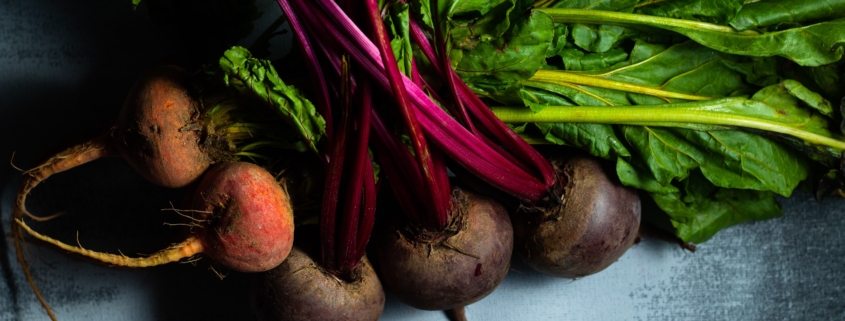Beets
February is Heart Month, and beets are beneficial to our heart health. The red color gives you a clue that they are nourishing to the blood.
Actually, the red-violet pigment that gives beets their rich color comes from a compound called Betaine, which has been show to improve vascular health, lower blood pressure, protect the liver from non-alcoholic fatty liver disease, and protect other organs from inflammation. (1)
Beets also contain nitrate, which the body converts to vasodilating nitric oxide, another mechanism of lowering blood pressure (2).
AND, beets are loaded with polyphenols (antioxidant), carotenoids (precursor to Vitamin A), vitamin C, folate (vitamin B12), iron, potassium and other minerals (2). These phytonutrients work together to nourish the blood, reduce oxidative stress, lower inflammation & blood pressure, protect the blood vessels, support the liver & improve eyesight (2, 3)
According to Ayurveda, the sweet-tasting and dense beet is provoking for kapha dosha, and raw beets are provoking to pitta, while cooked beets pacify pitta dosha (3). The cooling quality is what helps to pacify pitta. The antioxidant bioflavonoids also reduce disorders related to heat/fire such as allergies, inflammation and infection.
February is a great time of year to detoxify the liver, before the rising temperatures of spring bring a surge in blood flow and biochemical activity.

- 2 lbs beet root, peeled and chopped
- 2 medium onions
- 2 large carrots
- 1 lb green cabbage, thinly shredded
- 2 TBSP vegetable oil (olive or avocado work well)
- 2 cloves garlic
- 2 tsp fresh ginger, grated OR 2 tsp caraway seeds
- 5 cups vegetable stock
- juice of 1 lemon
- salt & pepper to taste
- Peel and cut the onions, carrots, beets and cabbage (you can use the shredding blade on a food processor to cut this prep time way down).
- Add the olive oil to a large stock pot and sautee the onions over medium heat. When onions are translucent, add the garlic and ginger/caraway seeds (I personally like the ginger, but caraway offers a more traditional flavor) and stir for one more minute.
- Next add carrots and beets and a pinch of salt. Sautee for 5-10 minutes, stirring often.
- Then add the vegetable stock and turn the heat to high. Add the cabbage and bring the pot to a boil.
- Simmer 15-25 minutes until the vegetables are soft.
- Remove from heat. Stir in lemon juice, and add salt & pepper to taste.
- Serve with sour cream, a wedge of lemon, or fresh parsley if desired.
Beet Muhammara (raw beet & walnut dip)
This was a customer favorite back in the day when we were offering more foods in the kitchen. Now you can enjoy it at home.
 Ingredients:
Ingredients:
- 3 large fresh Beets, peeled and quartered
- 1 ⅓ cups toasted Walnut Pieces (plus more for garnish)
- 3 large Garlic Cloves
- 1 tbsp Ground Cumin
- 1 ¼ tsp Sea Salt or to taste
- Freshly ground Black Pepper
- ⅛ tsp Red Pepper Flakes
- 2 tbsp Pomegranate Molasses or Mild Molasses (not blackstrap)
- 2-4 tbsp Lemon Juice
- 2-4 tbsp Olive Oil
Instructions:
- In a food processor, combine all ingredients and pulse to a textured paste.
- With the motor running, drizzle in the olive oil and process until fairly smooth but still textured.
- Taste and adjust seasonings and ingredients as desired. If you need to thicken it, you can add 1/3 cup of gluten-free panko bread crumbs.
- Garnish with walnuts or pomegranate seeds. Serve with carrot sticks, cucumbers, pita bread, toast or crackers.
- Store in an airtight container in the fridge. Will keep in the fridge up to 1 week.



